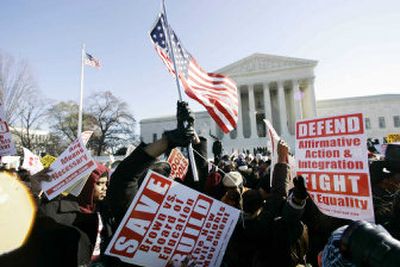Justices question schools’ diversity plans

WASHINGTON – A half century after the Supreme Court outlawed state-sponsored school segregation, five of nine justices indicated Monday that school systems may run afoul of the Constitution by using students’ race to promote diversity.
Cases from Seattle and Louisville, Ky., brought the divisive issue before the court for the first time since 2003, when a 5-4 ruling upheld the limited consideration of race in college admissions to attain a diverse student body.
A decision against the school districts could imperil similar plans in hundreds of districts nationwide and leave public school systems with a limited arsenal to maintain racial diversity. A ruling is expected by next summer.
In Monday’s cases, parents sued after their children were denied admission to the schools they preferred because of their race. The school policies in contention were upheld by federal appeals courts and are designed to keep schools from segregating along the same lines as neighborhoods.
Justice Anthony Kennedy, who could hold the decisive vote, joined his conservative colleagues in expressing deep skepticism about the programs.
School districts invite trouble by “characterizing each student by the color of his or her skin,” Kennedy said during the argument over the Seattle case. “It seems to me that should be allowed, if it’s ever allowed, as a measure of last resort.”
Lawyers for the parents and the Bush administration said the plans violate the Equal Protection Clause of the 14th Amendment, enacted after the Civil War as part of the effort to remedy the effects of slavery.
The issue presents a unique challenge to Louisville’s schools, which spent 25 years under a court order to eliminate the effects of state-sponsored segregation. The Jefferson County, Ky., school board, which encompasses Louisville, decided to keep much of the court-ordered plan in place to prevent schools from resegregating.
“What’s constitutionally required one day is constitutionally prohibited the next day? That’s very odd,” Justice Ruth Bader Ginsburg said, sentiments shared by her three liberal colleagues.
Chief Justice John Roberts and Justices Samuel Alito and Antonin Scalia expressed concern about the school plans. Justice Clarence Thomas asked no questions but has consistently voted against racial preference plans.
Scalia derided the school systems’ policies as a “whatever it takes” approach that improperly classifies on the basis of race.
Attorney Michael Madden, representing the Seattle school district, said race is but one factor, that it is relied on only in some instances and then only at the end of a lengthy process.
Madden drew a distinction between the Seattle school program and the subject of the court’s 2003 decision, which narrowly approved the University of Michigan law school’s affirmative action admissions program.
“This is not like being denied admission to a state’s flagship university,” Madden told Roberts. The Seattle students are “not being denied admission; they are being redistributed.”
Seattle suspended its program after parents sued.
Outside the court, affirmative action supporters bearing “Fight For Equality” placards marched on the sidewalk in a brisk wind. A parent-teacher group from Chicago and several civil rights groups were among those sponsoring the demonstration.
Among the crowd were representatives of the National Organization for Women, the NAACP and students from Howard University.
Though outnumbered, there were some in the crowd from the other side.
“Regardless of how well-motivated, allowing the state to engineer racial mixing only creates racial stereotypes and increases racial tension,” said Terry Pell, president of the Center for Individual Rights, a public interest law firm.